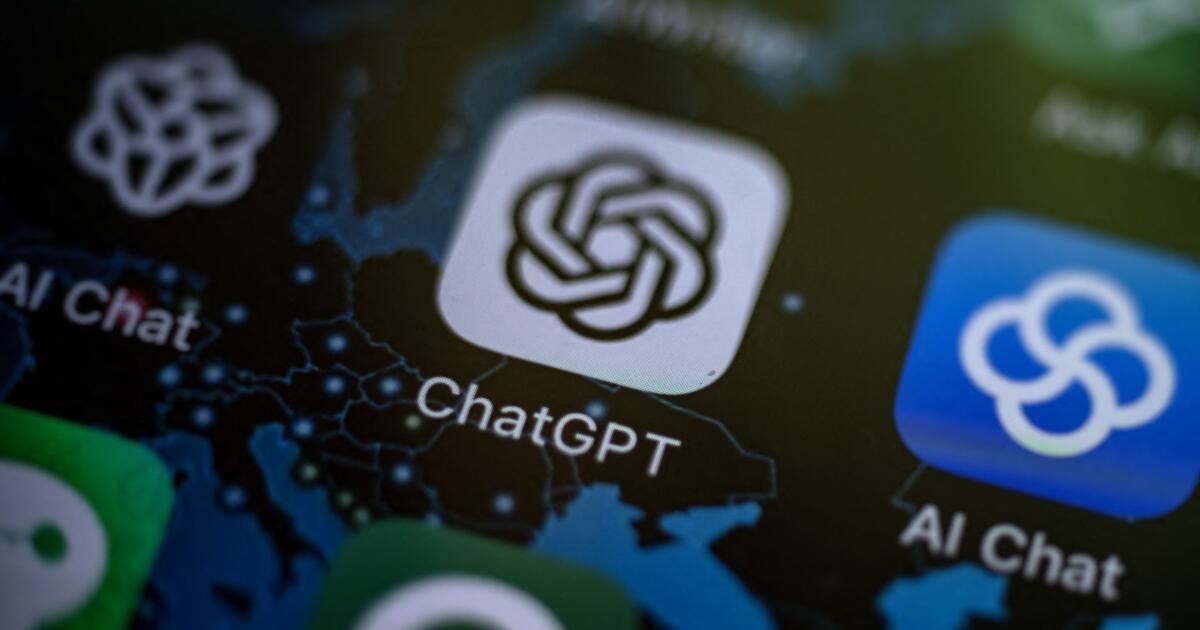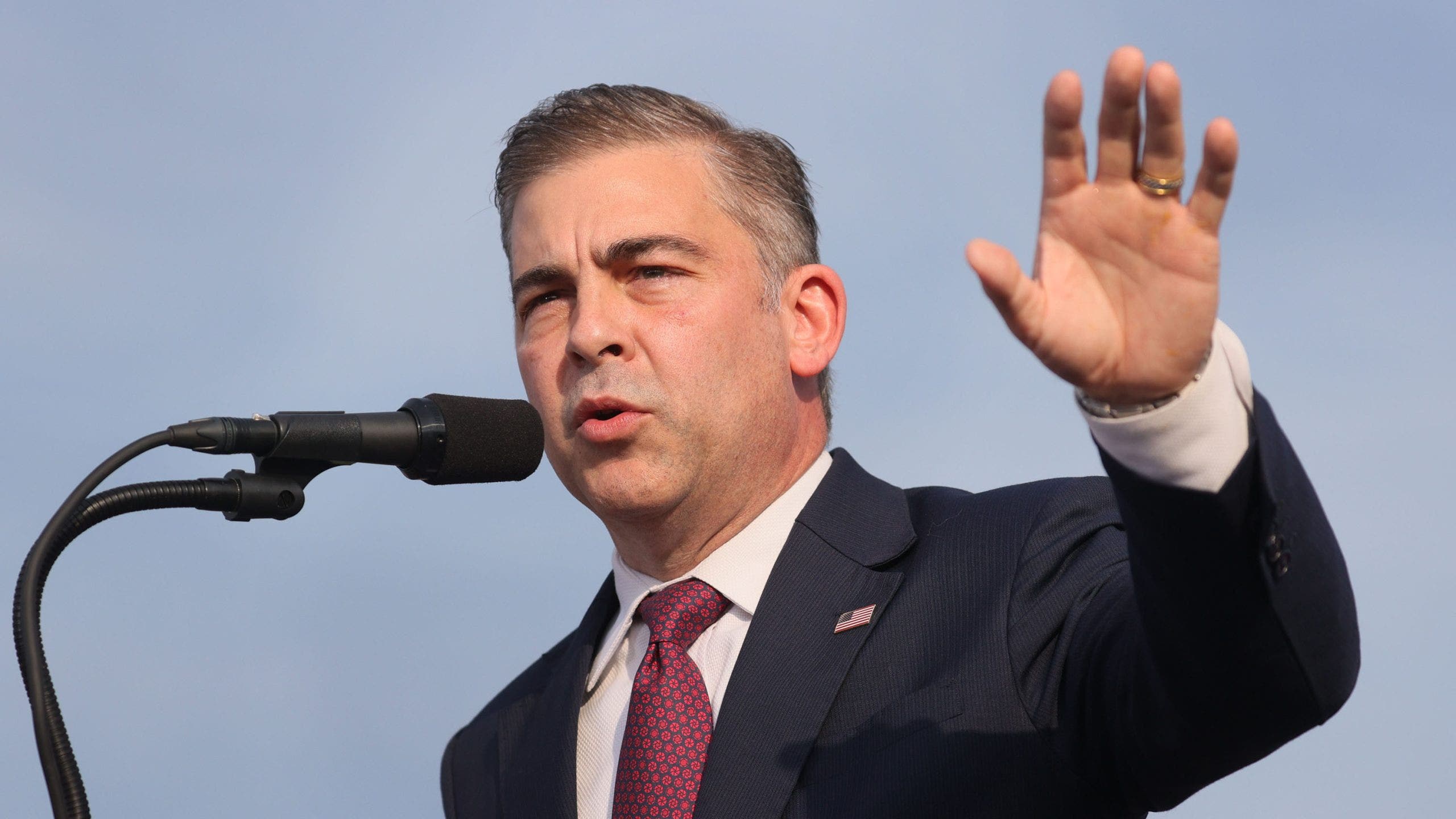Science
‘Dr. Google’ meets its match: Dr. ChatGPT

As a fourth-year ophthalmology resident at Emory University School of Medicine, Dr. Riley Lyons’ biggest responsibilities include triage: When a patient comes in with an eye-related complaint, Lyons must make an immediate assessment of its urgency.
He often finds patients have already turned to “Dr. Google.” Online, Lyons said, they are likely to find that “any number of terrible things could be going on based on the symptoms that they’re experiencing.”
So, when two of Lyons’ fellow ophthalmologists at Emory came to him and suggested evaluating the accuracy of the AI chatbot ChatGPT in diagnosing eye-related complaints, he jumped at the chance.
In June, Lyons and his colleagues reported in medRxiv, an online publisher of preliminary health science studies, that ChatGPT compared quite well to human doctors who reviewed the same symptoms — and performed vastly better than the symptom checker on the popular health website WebMD. And despite the much-publicized “hallucination” problem known to afflict ChatGPT — its habit of occasionally making outright false statements — the Emory study reported that the most recent version of ChatGPT made zero “grossly inaccurate” statements when presented with a standard set of eye complaints.
The relative proficiency of ChatGPT, which debuted in November 2022, was a surprise to Lyons and his co-authors. The artificial intelligence engine “is definitely an improvement over just putting something into a Google search bar and seeing what you find,” said co-author Dr. Nieraj Jain, an assistant professor at the Emory Eye Center who specializes in vitreoretinal surgery and disease.
But the findings underscore a challenge facing the healthcare industry as it assesses the promise and pitfalls of generative AI, the type of artificial intelligence used by ChatGPT: The accuracy of chatbot-delivered medical information may represent an improvement over Dr. Google, but there are still many questions about how to integrate this new technology into healthcare systems with the same safeguards historically applied to the introduction of new drugs or medical devices.
The smooth syntax, authoritative tone and dexterity of generative AI have drawn extraordinary attention from all sectors of society, with some comparing its future impact to that of the internet itself. In healthcare, companies are working feverishly to implement generative AI in areas such as radiology and medical records.
When it comes to consumer chatbots, though, there is still caution, even though the technology is already widely available — and better than many alternatives. Many doctors believe AI-based medical tools should undergo an approval process similar to the FDA’s regime for drugs, but that would be years away. It’s unclear how such a regime might apply to general-purpose AIs like ChatGPT.
“There’s no question we have issues with access to care, and whether or not it is a good idea to deploy ChatGPT to cover the holes or fill the gaps in access, it’s going to happen and it’s happening already,” Jain said. “People have already discovered its utility. So, we need to understand the potential advantages and the pitfalls.”
The Emory study is not alone in ratifying the relative accuracy of the new generation of AI chatbots. A report published in Nature in early July by a group led by Google computer scientists said answers generated by Med-PaLM, an AI chatbot the company built specifically for medical use, “compare favorably with answers given by clinicians.”
AI may also have a better bedside manner. Another study, published in April in JAMA Internal Medicine, even noted that healthcare professionals rated ChatGPT answers as more empathetic than responses from human doctors.
Indeed, a number of companies are exploring how chatbots could be used for mental health therapy, and some investors in the companies are betting that healthy people might also enjoy chatting and even bonding with an AI “friend.” The company behind Replika, one of the most advanced of that genre, markets its chatbot as, “The AI companion who cares. Always here to listen and talk. Always on your side.”
“We need physicians to start realizing that these new tools are here to stay and they’re offering new capabilities both to physicians and patients,” said James Benoit, an AI consultant.
While a postdoctoral fellow in nursing at the University of Alberta in Canada, he published a preliminary study in February reporting that ChatGPT significantly outperformed online symptom checkers in evaluating a set of medical scenarios. “They are accurate enough at this point to start meriting some consideration,” he said.
Still, even the researchers who have demonstrated ChatGPT’s relative reliability are cautious about recommending that patients put their full trust in the current state of AI. For many medical professionals, AI chatbots are an invitation to trouble: They cite a host of issues relating to privacy, safety, bias, liability, transparency, and the current absence of regulatory oversight.
The proposition that AI should be embraced because it represents a marginal improvement over Dr. Google is unconvincing, these critics say.
“That’s a little bit of a disappointing bar to set, isn’t it?” said Dr. Mason Marks, a professor who specializes in health law at Florida State University. “I don’t know how helpful it is to say, ‘Well, let’s just throw this conversational AI on as a band-aid to make up for these deeper systemic issues,’” he said in an interview.
The biggest danger, in his view, is the likelihood that market incentives will result in AI interfaces designed to steer patients to particular drugs or medical services. “Companies might want to push a particular product over another,” Marks said. “The potential for exploitation of people and the commercialization of data is unprecedented.”
OpenAI, the company that developed ChatGPT, also urged caution.
“OpenAI’s models are not fine-tuned to provide medical information,” a company spokesperson said. “You should never use our models to provide diagnostic or treatment services for serious medical conditions.”
John Ayers, a computational epidemiologist at UC San Diego who was the lead author of the JAMA Internal Medicine study, said that as with other medical interventions, the focus should be on patient outcomes.
“If regulators came out and said that if you want to provide patient services using a chatbot, you have to demonstrate that chatbots improve patient outcomes, then randomized controlled trials would be registered tomorrow for a host of outcomes,” Ayers said.
He would like to see a more urgent stance from regulators.
“One hundred million people have ChatGPT on their phone,” said Ayers, “and are asking questions right now. People are going to use chatbots with or without us.”
At present, though, there are few signs that rigorous testing of AIs for safety and effectiveness is imminent. In May, Dr. Robert Califf, the commissioner of the FDA, described “the regulation of large language models as critical to our future,” but aside from recommending that regulators be “nimble” in their approach, he offered few details.
In the meantime, the race is on. In July, the Wall Street Journal reported that the Mayo Clinic was partnering with Google to integrate the Med-PaLM 2 chatbot into its system. In June, WebMD announced it was partnering with a Pasadena-based startup, HIA Technologies Inc., to provide interactive “digital health assistants.” And the ongoing integration of AI into both Microsoft’s Bing and Google Search suggests that Dr. Google is already well on its way to being replaced by Dr. Chatbot.
This article was produced by KFF Health News, which publishes California Healthline, an editorially independent service of the California Health Care Foundation.

Science
Cluster of farmworkers diagnosed with rare animal-borne disease in Ventura County

A cluster of workers at Ventura County berry farms have been diagnosed with a rare disease often transmitted through sick animals’ urine, according to a public health advisory distributed to local doctors by county health officials Tuesday.
The bacterial infection, leptospirosis, has resulted in severe symptoms for some workers, including meningitis, an inflammation of the brain lining and spinal cord. Symptoms for mild cases included headaches and fevers.
The disease, which can be fatal, rarely spreads from human to human, according to the U.S. Centers for Disease Control and Prevention.
Ventura County Public Health has not given an official case count but said it had not identified any cases outside of the agriculture sector. The county’s agriculture commissioner was aware of 18 cases, the Ventura County Star reported.
The health department said it was first contacted by a local physician in October, who reported an unusual trend in symptoms among hospital patients.
After launching an investigation, the department identified leptospirosis as a probable cause of the illness and found most patients worked on caneberry farms that utilize hoop houses — greenhouse structures to shelter the crops.
As the investigation to identify any additional cases and the exact sources of exposure continues, Ventura County Public Health has asked healthcare providers to consider a leptospirosis diagnosis for sick agricultural workers, particularly berry harvesters.
Rodents are a common source and transmitter of disease, though other mammals — including livestock, cats and dogs — can transmit it as well.
The disease is spread through bodily fluids, such as urine, and is often contracted through cuts and abrasions that contact contaminated water and soil, where the bacteria can survive for months.
Humans can also contract the illness through contaminated food; however, the county health agency has found no known health risks to the general public, including through the contact or consumption of caneberries such as raspberries and blackberries.
Symptom onset typically occurs between two and 30 days after exposure, and symptoms can last for months if untreated, according to the CDC.
The illness often begins with mild symptoms, with fevers, chills, vomiting and headaches. Some cases can then enter a second, more severe phase that can result in kidney or liver failure.
Ventura County Public Health recommends agriculture and berry harvesters regularly rinse any cuts with soap and water and cover them with bandages. They also recommend wearing waterproof clothing and protection while working outdoors, including gloves and long-sleeve shirts and pants.
While there is no evidence of spread to the larger community, according to the department, residents should wash hands frequently and work to control rodents around their property if possible.
Pet owners can consult a veterinarian about leptospirosis vaccinations and should keep pets away from ponds, lakes and other natural bodies of water.
Science
Political stress: Can you stay engaged without sacrificing your mental health?

It’s been two weeks since Donald Trump won the presidential election, but Stacey Lamirand’s brain hasn’t stopped churning.
“I still think about the election all the time,” said the 60-year-old Bay Area resident, who wanted a Kamala Harris victory so badly that she flew to Pennsylvania and knocked on voters’ doors in the final days of the campaign. “I honestly don’t know what to do about that.”
Neither do the psychologists and political scientists who have been tracking the country’s slide toward toxic levels of partisanship.
Fully 69% of U.S. adults found the presidential election a significant source of stress in their lives, the American Psychological Assn. said in its latest Stress in America report.
The distress was present across the political spectrum, with 80% of Republicans, 79% of Democrats and 73% of independents surveyed saying they were stressed about the country’s future.
That’s unhealthy for the body politic — and for voters themselves. Stress can cause muscle tension, headaches, sleep problems and loss of appetite. Chronic stress can inflict more serious damage to the immune system and make people more vulnerable to heart attacks, strokes, diabetes, infertility, clinical anxiety, depression and other ailments.
In most circumstances, the sound medical advice is to disengage from the source of stress, therapists said. But when stress is coming from politics, that prescription pits the health of the individual against the health of the nation.
“I’m worried about people totally withdrawing from politics because it’s unpleasant,” said Aaron Weinschenk, a political scientist at the University of Wisconsin–Green Bay who studies political behavior and elections. “We don’t want them to do that. But we also don’t want them to feel sick.”
Modern life is full of stressors of all kinds: paying bills, pleasing difficult bosses, getting along with frenemies, caring for children or aging parents (or both).
The stress that stems from politics isn’t fundamentally different from other kinds of stress. What’s unique about it is the way it encompasses and enhances other sources of stress, said Brett Ford, a social psychologist at the University of Toronto who studies the link between emotions and political engagement.
For instance, she said, elections have the potential to make everyday stressors like money and health concerns more difficult to manage as candidates debate policies that could raise the price of gas or cut off access to certain kinds of medical care.
Layered on top of that is the fact that political disagreements have morphed into moral conflicts that are perceived as pitting good against evil.
“When someone comes into power who is not on the same page as you morally, that can hit very deeply,” Ford said.
Partisanship and polarization have raised the stakes as well. Voters who feel a strong connection to a political party become more invested in its success. That can make a loss at the ballot box feel like a personal defeat, she said.
There’s also the fact that we have limited control over the outcome of an election. A patient with heart disease can improve their prognosis by taking medicine, changing their diet, getting more exercise or quitting smoking. But a person with political stress is largely at the mercy of others.
“Politics is many forms of stress all rolled into one,” Ford said.
Weinschenk observed this firsthand the day after the election.
“I could feel it when I went into my classroom,” said the professor, whose research has found that people with political anxiety aren’t necessarily anxious in general. “I have a student who’s transgender and a couple of students who are gay. Their emotional state was so closed down.”
That’s almost to be expected in a place like Wisconsin, whose swing-state status caused residents to be bombarded with political messages. The more campaign ads a person is exposed to, the greater the risk of being diagnosed with anxiety, depression or another psychological ailment, according to a 2022 study in the journal PLOS One.
Political messages seem designed to keep voters “emotionally on edge,” said Vaile Wright, a licensed psychologist in Villa Park, Ill., and a member of the APA’s Stress in America team.
“It encourages emotion to drive our decision-making behavior, as opposed to logic,” Wright said. “When we’re really emotionally stimulated, it makes it so much more challenging to have civil conversation. For politicians, I think that’s powerful, because emotions can be very easily manipulated.”
Making voters feel anxious is a tried-and-true way to grab their attention, said Christopher Ojeda, a political scientist at UC Merced who studies mental health and politics.
“Feelings of anxiety can be mobilizing, definitely,” he said. “That’s why politicians make fear appeals — they want people to get engaged.”
On the other hand, “feelings of depression are demobilizing and take you out of the political system,” said Ojeda, author of “The Sad Citizen: How Politics is Depressing and Why it Matters.”
“What [these feelings] can tell you is, ‘Things aren’t going the way I want them to. Maybe I need to step back,’” he said.
Genessa Krasnow has been seeing a lot of that since the election.
The Seattle entrepreneur, who also campaigned for Harris, said it grates on her to see people laughing in restaurants “as if nothing had happened.” At a recent book club meeting, her fellow group members were willing to let her vent about politics for five minutes, but they weren’t interested in discussing ways they could counteract the incoming president.
“They’re in a state of disengagement,” said Krasnow, who is 56. She, meanwhile, is looking for new ways to reach young voters.
“I am exhausted. I am so sad,” she said. “But I don’t believe that disengaging is the answer.”
That’s the fundamental trade-off, Ojeda said, and there’s no one-size-fits-all solution.
“Everyone has to make a decision about how much engagement they can tolerate without undermining their psychological well-being,” he said.
Lamirand took steps to protect her mental health by cutting social media ties with people whose values aren’t aligned with hers. But she will remain politically active and expects to volunteer for phone-banking duty soon.
“Doing something is the only thing that allows me to feel better,” Lamirand said. “It allows me to feel some level of control.”
Ideally, Ford said, people would not have to choose between being politically active and preserving their mental health. She is investigating ways to help people feel hopeful, inspired and compassionate about political challenges, since these emotions can motivate action without triggering stress and anxiety.
“We want to counteract this pattern where the more involved you are, the worse you are,” Ford said.
The benefits would be felt across the political spectrum. In the APA survey, similar shares of Democrats, Republicans and independents agreed with statements like, “It causes me stress that politicians aren’t talking about the things that are most important to me,” and, “The political climate has caused strain between my family members and me.”
“Both sides are very invested in this country, and that is a good thing,” Wright said. “Antipathy and hopelessness really doesn’t serve us in the long run.”
Science
Video: SpaceX Unable to Recover Booster Stage During Sixth Test Flight

President-elect Donald Trump joined Elon Musk in Texas and watched the launch from a nearby location on Tuesday. While the Starship’s giant booster stage was unable to repeat a “chopsticks” landing, the vehicle’s upper stage successfully splashed down in the Indian Ocean.
-

 Business1 week ago
Business1 week agoColumn: Molly White's message for journalists going freelance — be ready for the pitfalls
-

 Science6 days ago
Science6 days agoTrump nominates Dr. Oz to head Medicare and Medicaid and help take on 'illness industrial complex'
-

 Politics1 week ago
Politics1 week agoTrump taps FCC member Brendan Carr to lead agency: 'Warrior for Free Speech'
-
/cdn.vox-cdn.com/uploads/chorus_asset/file/25739950/247386_Elon_Musk_Open_AI_CVirginia.jpg)
/cdn.vox-cdn.com/uploads/chorus_asset/file/25739950/247386_Elon_Musk_Open_AI_CVirginia.jpg) Technology1 week ago
Technology1 week agoInside Elon Musk’s messy breakup with OpenAI
-

 Lifestyle1 week ago
Lifestyle1 week agoSome in the U.S. farm industry are alarmed by Trump's embrace of RFK Jr. and tariffs
-

 World1 week ago
World1 week agoProtesters in Slovakia rally against Robert Fico’s populist government
-

 Health2 days ago
Health2 days agoHoliday gatherings can lead to stress eating: Try these 5 tips to control it
-

 News1 week ago
News1 week agoThey disagree about a lot, but these singers figure out how to stay in harmony



/cdn.vox-cdn.com/uploads/chorus_asset/file/25286459/247024_Pilot_Pen_CVirginia.jpg)










